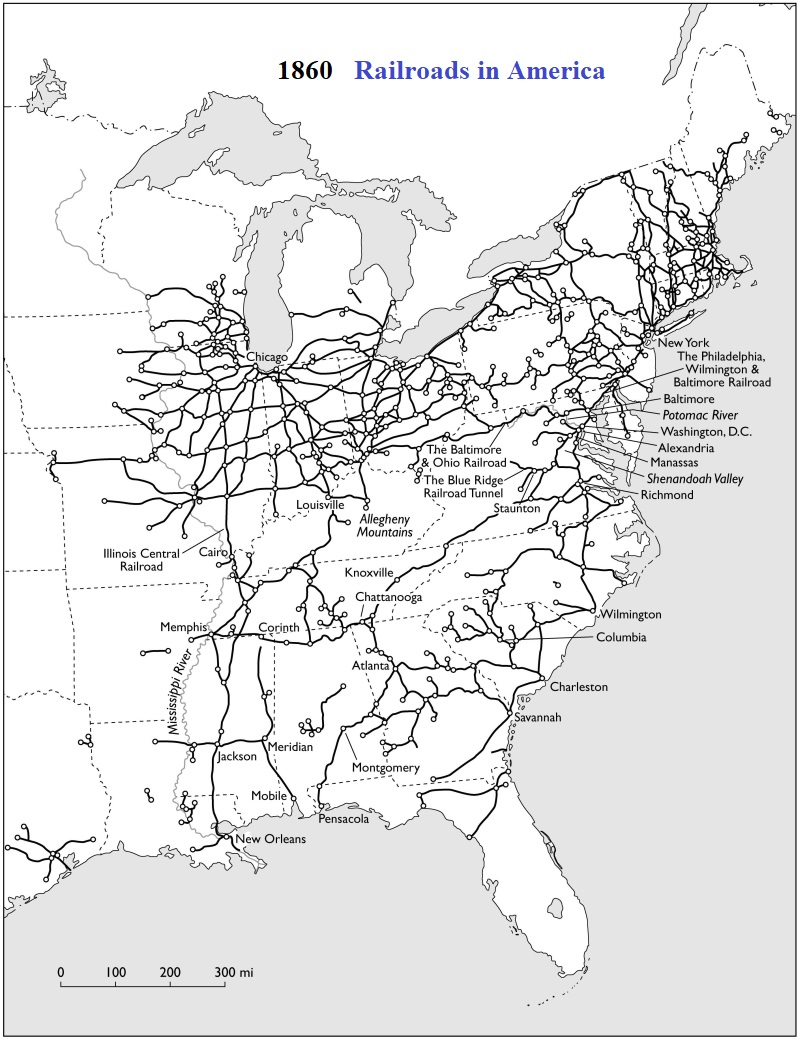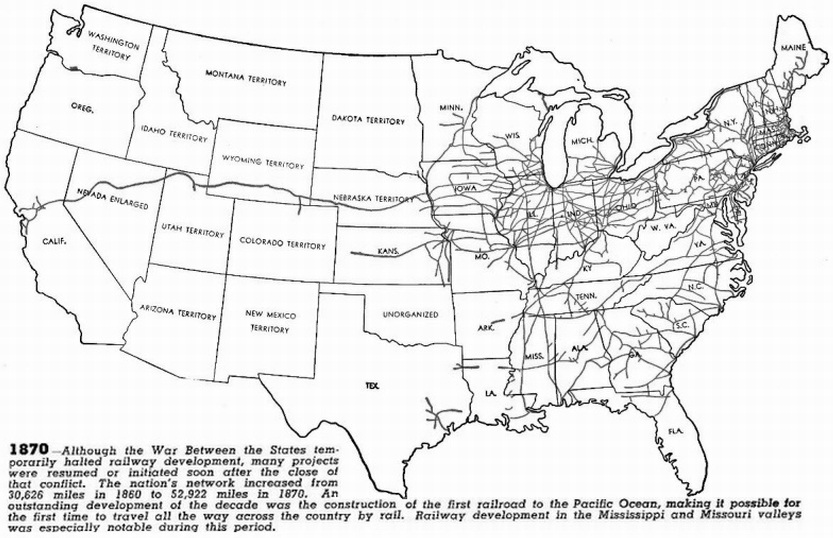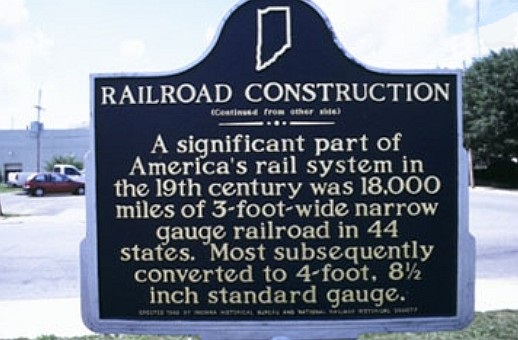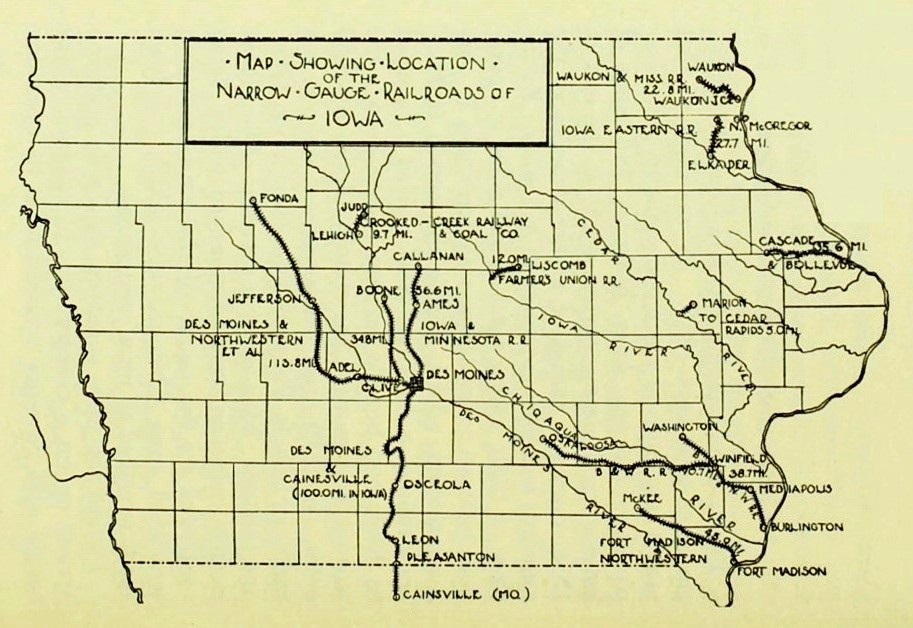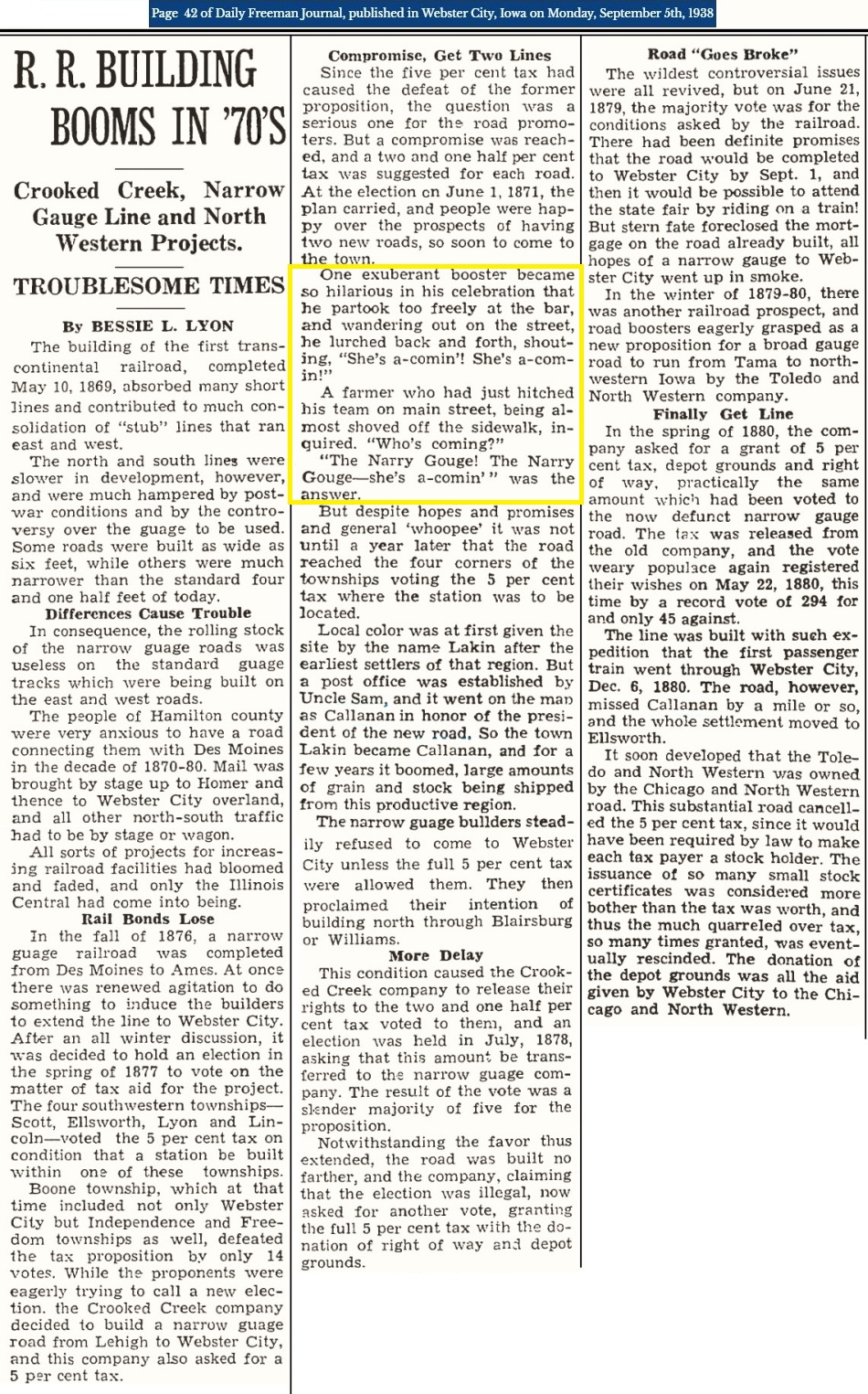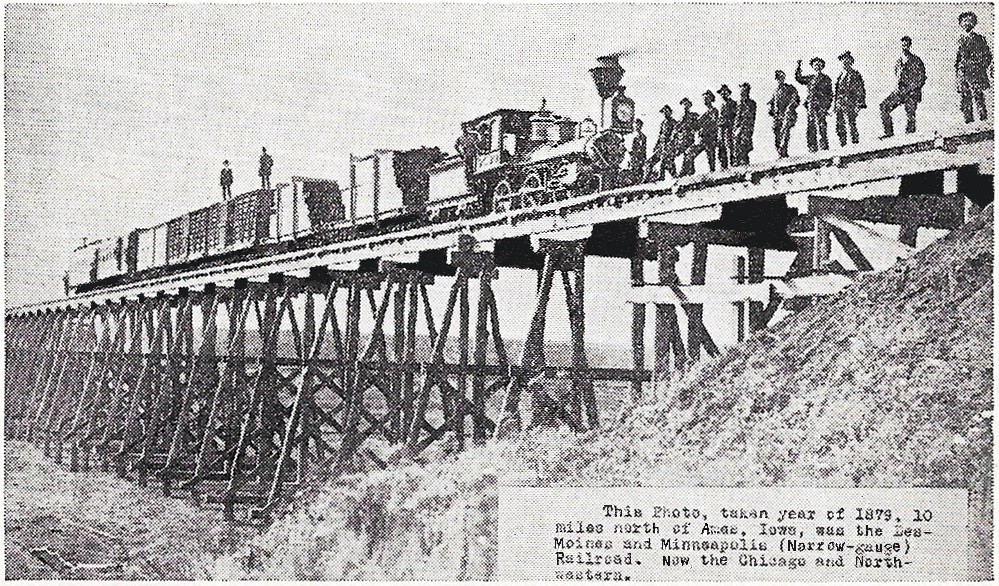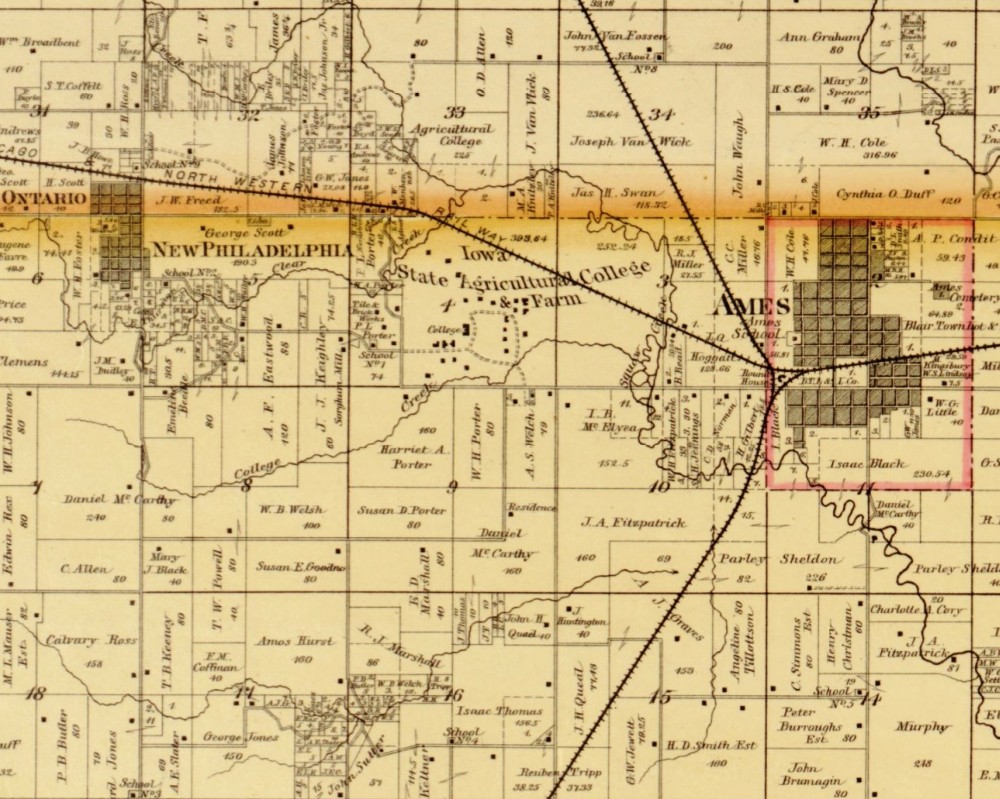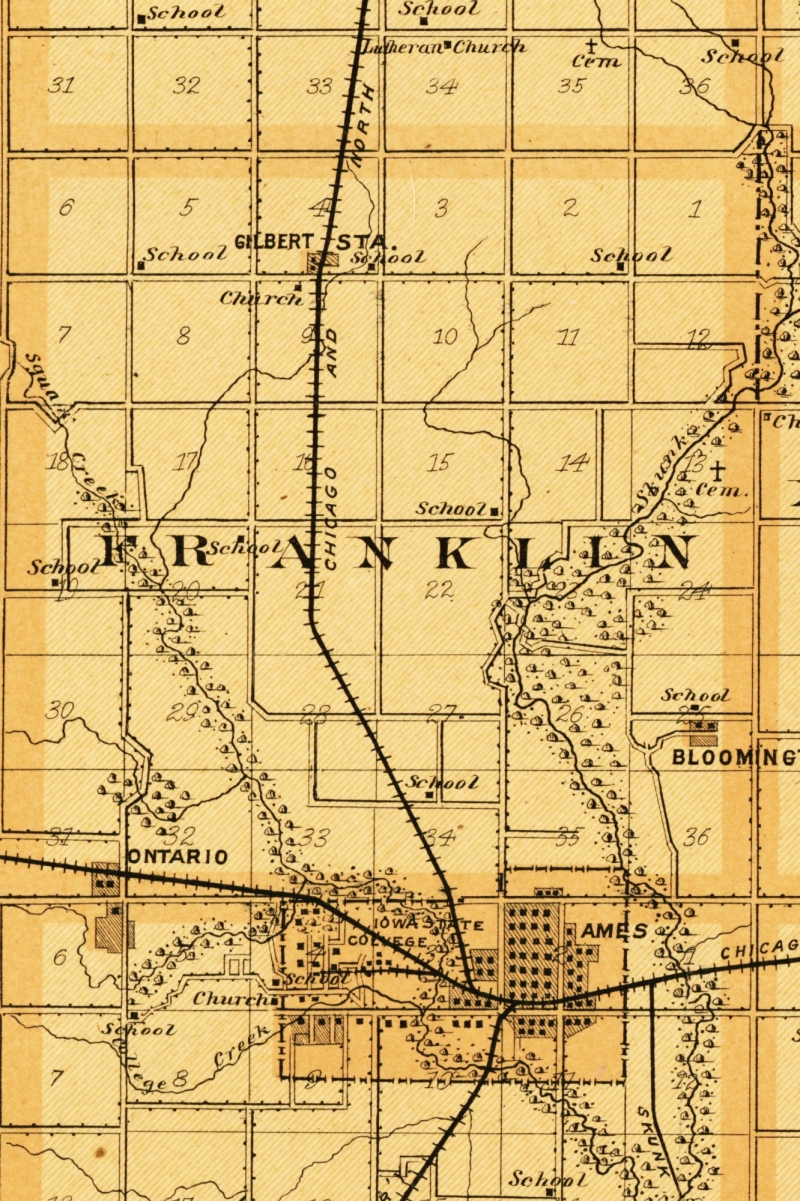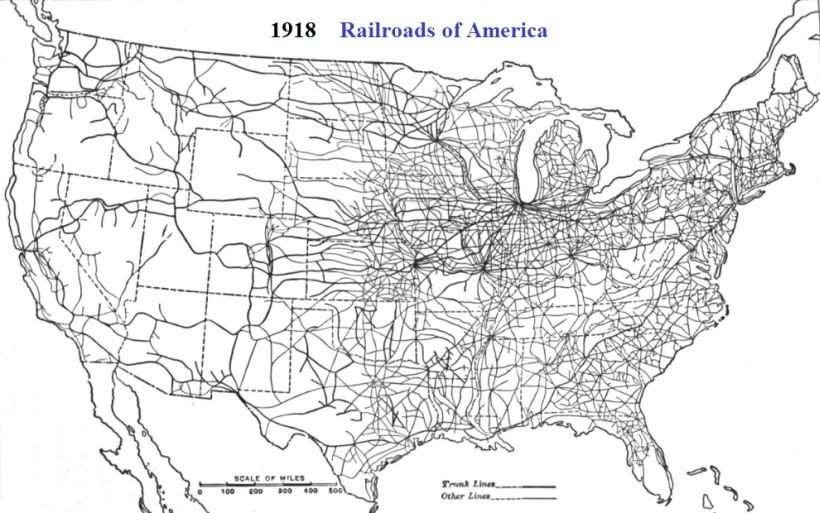Track laying was to continue
through the winter, except when the weather prevented, and the company
hoped to take the northern members of the Iowa Legislature to a connection
with the Chicago & North Western at Ames at the time of their
adjournment next spring.
Des Moines &
Minnesota's first piece of rolling stock was a push car built in Des
Moines by the Eagle Iron Works. This appears to have been the
sum total of construction equipment used for the early track laying.
By mid January temperatures as low as 15 degrees below zero were common,
slowing track laying.
As the end of January, the
railroad asked the City of Ames for free depot grounds and $10,000 in cash.
The Cedar Rapids and Missouri River Railroad's offer of free station
grounds to the Iowa & Minnesota at Ames evidently did not carry
over to the Des Moines & Minnesota. It was estimated
to cost only $1,000 to get the old right of way between Ames and Polk City,
ready to lay track, noting that the Iowa & Minnesota built bridges
were still in good condition.
The last day of January, 1874
saw the first true rolling stock arrive at Des Moines, consisting of two
new flat cars, 26' long and seven and one half feet wide sporting 24" trucks.
It would not be until February 6th before they were actually unloaded off
the standard gauge flats that carried them to Des Moines from Cincinnati
and placed on the narrow gauge rails. What was the hurry?
They had no locomotive with which to use them!
By mid-February, 1874, rapid
progress was being made. The last seven miles of grading was
being finished up south of Polk City, all of the ties contracted for, with
many already delivered, and a locomotive was finally on order.
Four miles of track was completed north from Des Moines and it was being
laid at the rate of 1,000 feet per day. The railroad was also
finished up track work between Vine and Court Streets at Des Moines in
preparation for the arrival of the new locomotive. The best
news was that $5,000 worth of the $200,000 first mortgage bonds, authorized
back in November 1873, had been sold.
Des Moines and Minnesota
announced on March 18, 1874, their construction costs, so far, had been
less than original estimates. They claimed cost per mile was
$7,000 and equipped at $9,000. The break down per mile as follows:
Grading $5000, ties $600, 30 pound rails and spikes $4,000, splice bars
$200, engineering $200, right of way $2000, and station buildings, water
tanks, etc. another $600. This made the total actually $6,3000
per mile.
March 26, 1874, the first
Des
Moines & Minnesota locomotive arrived in Des Moines via the Chicago
Rock Island & Pacific Railroad. The following day it
was unloaded, and the next steamed up. The "Granger", as it
was named, had been built by National Locomotive Works of Connellville,
Pa., was a 0-6-0 with 36" drivers, 11x16 cylinders and had a tender holding
550 gallons of water and one and one half tons of coal. With
a weight of 15 tons it had cost the railroad $7,500. To supply
water for the locomotive, a city water hydrant was installed at East Locust
Street.
The local newpaper editor,
in a typical April Fools Day joke, printed that the Des Moines &
Minnesota would place at the disposal of the public all their passenger
cars for a free excursion to the end of the line. The train
would leave from East 4th and Locust at 10 A.M. sharp. Many
potential riders arrived at the enginehouse bright and early that morning
and after waiting an hour or so decided it prudent to look for the missing
coaches. It was soon discovered the railroad did not own any
passenger cars and only then was it recalled the date was April 1st!
This next image is a portion
of the 1875 Andreas Atlas Map showing
the Des Moines, Indianola
& Missouri Railroad narrow gauge railroad coming to Des Moines
from the south, joining with
the Chicago Rock Island & Pacific Railroad line until
Fourth Steet
where it turned north to head
towards Polk City and Ames as the Des Moines & Minnesota Railroad.
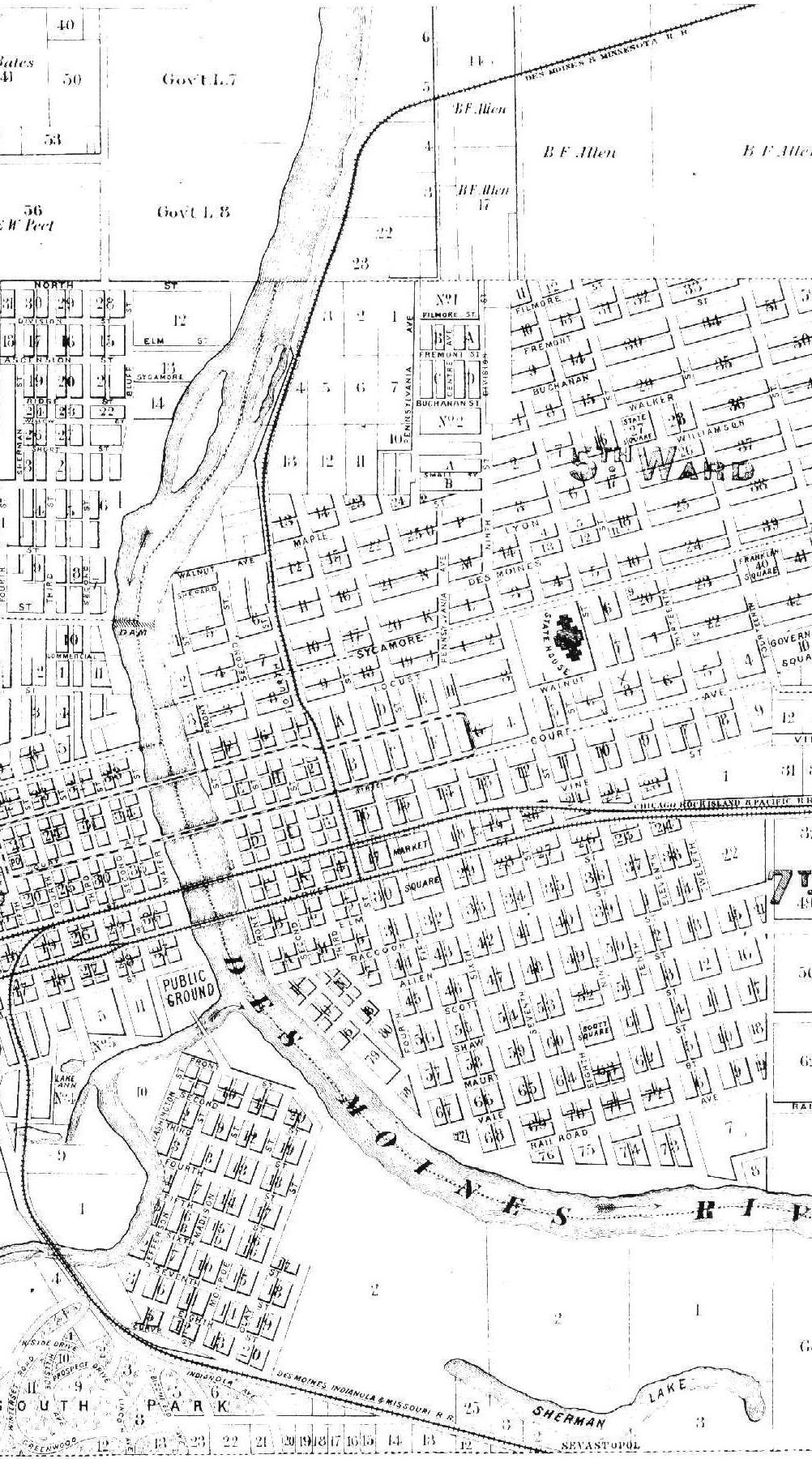
(Click on this 1875 narrow gauge railroad portion of
Des Moines to see the large map showing the entire city.)
April 4, 1874, was set for
the first test trip for the Granger. The Board of Directors
and stockholders gathered, but for some unrecorded reason, the trip was
not made until April 7th. It was said the Granger took two
carloads of rail and one carload of directors. Since it had
been reported the railroad only had two flat cars, it is possible that
the directors rode abourd the handcar tied to the rear of the little train.
The locomotive operated successfully, even up and down the steep grade
called Haast Cut, which was traversed in leaving the Des Moines River Valley
floor to attain the high prairie land.
A more formal public excursion
was scheduled for April 10, 1874. Leaving the enginehouse on
East 4th Street, with two carloads of excursionists, the train was stopped
on the big hill, due to a pair of ladies walking on the tracks.
The Granger had no problem starting back up on the grade and continued
to the end of the track at a point two and one half miles from Des Moines.
An interesting fact was discovered
as to the coaling of the Granger. This action took place at
a point two miles north of Locust Street at Peterson's Bank, a slope coal
mine, located only 30 feet from the railroad right of way. The locomotive
consumed one ton of coal per day operating at the rate of 15 M.P.H.
The locomotive's engineer Ben Rees, an ex Rock Island man, said
he was of the opinion it would only take one and one half tons of coal
to run all the way to Ames.
By the first of May, 1874,
track had been completed to the Poor Farm (Saylor), 70 tons of rails had
just been received and the narrow gauge decided to build a spur track a
couple blocks to the Rock Island depot in East Des Moines in order
to make the transfer of the rail easier.
On May 19, 1874, Dr. Ankeny, a director of the Des
Moines & Minneapolis, started east to place orders for a locomotive,
coach, mail & Express, and baggage cars. There were now
nine freight cars, flats and boxes in service supplying material to the
tracklayers. Regular freight service was also being conducted
along the route as the rails were being laid. One man was shipping
hard wood lumber to Omaha via the Des Moines & Minnesota and
a local farmer was moving oats to Des Moines for trans-shipment into
Rock
Island boxcars for Chicago. The construction train provided
this service to the public.
The track was completed to
Polk City on June 4, 1874, and on June 9th an excursion for local politicians
was operated into Polk City. Starting 6/27/74, regular train
service was commenced. (A second hand passenger locomotive, baggage
car and a coach had been received). Des Moines to the end of
track north of Polk City. Numbers 1 and 2 would run northbound
while numbers 3 and 4 would be their counterparts.
Construction crews were making
good time in spite of the heavy rains which fell during June, awith their
associated washouts, and by July 1, 1874, trains were running to a point
9 miles south of Ames. It is interesting to note that stagecoaches
connected the end of the track to the Chicago & North Western
trains at Ames, allowing passengers somewhat of a smooth transition between
the two railroads. Two days later rails reached the Squaw Creek
Bridge and the Des Moines & Minnesota commenced train operations
by regular published timetable schedule.
Ames is finally reached on
July 27, 1874, and a special excursion operated over the completed route
on July 29, 1874. 600 citizens boarded the special at Des Moines
and the little "pony engine" pulled out at 8 A.M. The seven
carloads of passengers were met at Ames about 10:30 A. M. by a throng of
well wishers estimated to be 1,000 strong. A band played, a
cannon boomed and the crowd marched 1/2 mile to a large grove.
Here dinner was served, followed by the usual speeches. At
3 o'clock good-byes were said, and the train headed back to Des Moines.
Business swamped the Des
Moines & Minnesota from the start, far beyond all projections,
and they simply did not have enough equipment for the passenger or freight
business. The excursion business was especially good and many
a rider was accommodated on flat cars equipped with side railing.
It was noted on September 1 the regular passenger train carried several
boxcars, in addition to the coaches, to accommodate all the ticket holders.
Early September 1874 saw turntables
in place at Ames and Des Moines, side tracks built at all the stations
along the line and a roundhouse under construction at Des Moines.
The depot buildings at Polk City and Ames were completed but work continued
on the Des Moines facility.
So popular was the narrow
gauge, a delegation of Boone citizens contacte the railroad officials asking
for a branch line from Polk City. The Des Moines & Minnesota
must have been interested because on September 19, 1874, it was announced
a survey would commence the following week.
A big snowstorm on January
9, 1875 completely halted all operations: even the recently constructed
snowplow was no match for Mother Nature. The 25 degree below
zero temperatures even froze up the locomotive air pumps. The
locomotive Granger blew up near Ames while plowing snow, but damage could
not have been very great. It was back in service the following
week.
This portion of the 1875 Andreas
Atlas Map shows
the Des Moines & Minnesota
narrow gauge railroad completed through Polk County.
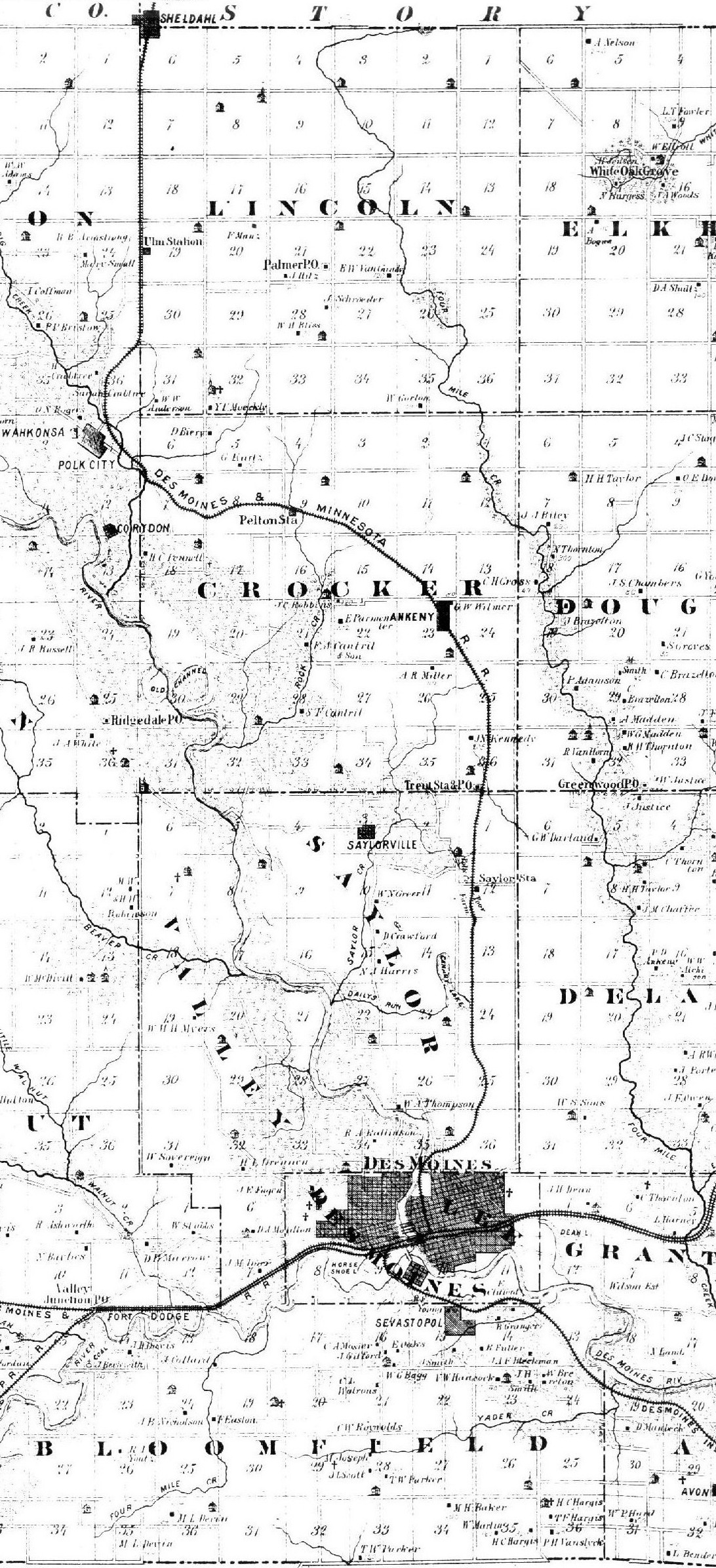
(Click on this 1875 narrow gauge railroad portion to
see the whole map showing all of Polk County.)
On the morning of April
7, 1875, a coupling pin bounced out and left the passenger train standing
on the prairie near the Poor Farm. The rest of the train was
nearly to Des Moines before the loss was discovered.
The Des Moines &
Minnesota kept adding rolling stock and motive power as fast as possible,
with five locomotives in service by the summer of 1875. These
were named the Granger, F. R. West, Diamond Joe, James Callanan and the
J. J. Stewart.
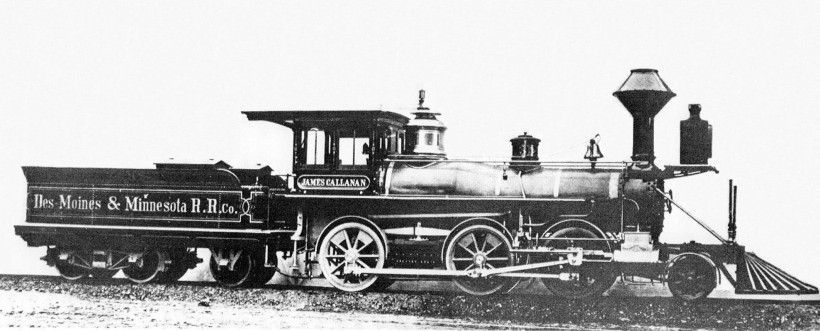
Express service was inaugurated in December, 1875,
that consisted of a round trip leaving Des Moines at 10:30 P.M. connecting
with both east and west bound Chicago & North Western trains
at Ames.
In the winter of 1875/1876,
the narrow gauge decided that the locomotive Granger, demoted to switcher
status, was just too small. It was traded to Grant Locomotive
Works on a new larger engine which was placed in service in early April
1876. Shop facilities were such that a combine car was built
in Des Moines for a cost of $509 less than to purchase it from a builder
in the east.
The first reported accident
of any consequence was the derailment of the snowplow on December 9, 1876,
near the State Agricultural College near Ames.
This portion of the 1875 Andreas
Atlas Map shows
the Des Moines & Minnesota
narrow gauge railroad completed to Ames.
Notice that in 1875 there was
no Gilbert Station because the Des Moines & Minnesota
narrow gauge had not yet headed north from Ames.
Iowa State University was then
known as State Agricultural College & Farm.

(Click on this 1875 narrow gauge railroad portion to
see the whole map showing all of Story County.)
In the spring of 1877, there
was talk of extending the Des Moines & Minnesota northward from
Ames toward the Minnesota State line. There was talk of a branch
line running from the proposed main line at Williams, that would served
Eagle Grove and Humboldt. Three different townships along the
proposed route already had voted the railroad a 5 percent tax, but the
citizens of Webster City voted no.
The Des Moines & Minnesota
were one of the few railroads in Iowa that paid interest on its bonds and
at the same time carried a surplus fund. It demonstrated that
narrow gauge lines could be a paying proposition.
July 31, 1877, the Des
Moines & Minnesota was reorganized as the Des Moines & Minneapolis
Railroad Company, no doubt to be able to sell the new bonds required
to cover the cost of the proposed extension to Minnesota and a Twin Cities
connection. On August 8, 1877, Superintendent Smart went east
to sell these new bonds. He must have been fairly successful
in his bid to find willing purchasers, for it was said on October 19, 1877,
rails and ties for a 22 mile section towards Webster City were on order.
It was also noted that 9 miles were already graded and waiting for those
rails and ties to arrive October 26th saw the rail laying commence.
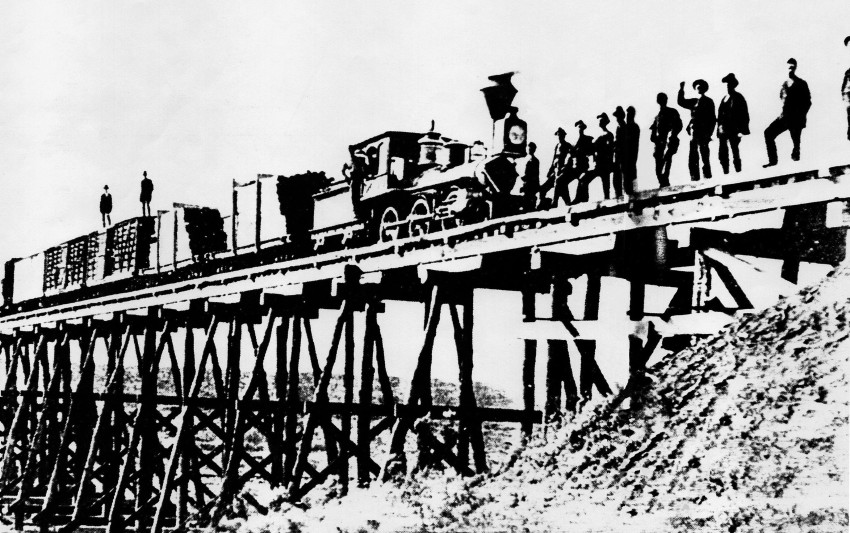
Narrow Gauge wood trestle bridge over Keigley Creek (about 1880)
between Gilbert Station and Story City
(Click to see the standard gauge rail bridge which replaced this
trestle mid 1882.)
A December 7, 1877 construction
report by Locating Engineer E E. Moor said 22 miles of right of way were
graded and tied. With the rail laying crew moving at the rate
of one mile per day, construction trains reached Story City on December
29, 1877.
By Janary 30, 1878, tracklayers
had completed their work to Callanan and passenger trains were calling
at the terminus in early March 1878.
In April 1878, it was stated
the Des Moines & Minneapolis plans called for construction to
Humboldt to be completed that year. (In late 1877, the railroad
had claimed to have over six miles graded on this line.)
The costly and time consuming
job of trans-loading freight between narrow and standard gauge freight
cars prompted a study, completed in June, 1878, by the Des Moines &
Minneapolis whereby the idea of switching trucks from under the standard
gauge cars to narrow gauge would allow them to move this business much
quicker and at a lower cost. Nothing more of this idea was
ever seen... switching the track gauge solved the problem in 1880.
The July 1878 vote by Webster
City citizens reversed an earlier feeling and gave the Des Moines &
Minneapolis $34,000 in tax money to build the line north from the present
end of track at Callanan. This money must have had some effect
of the railroad officials because President Callanan went east in August
to purchase rail for Webster City extension.
October 1878, the Des Moines
& Minneapolis was considering the construction of a by-pass line
to avoid the steep grades into and out of Polk City. This would
allow the operation of longer and heavier trains with the same motive power
and at the same time shorten the route by two miles. Needless
to say, Polk City residents were not happy at all with the prospect of
ending up at the end of a branch line, after having subscribed to taxes
to aid the original construction of the line through the town.
The narrow gauge company did a preliminary survey, but it would take Chicago
& North Western control of the Des Moines & Minneapolis
before this work would actualy be completed.
July 1, 1879, the Des Moines
& Minneapolis defaulted in the interest payment on its bonds, amounting
to $178,000, held by John Blair and John Alley, large stockholders in the
Chicago
& North Western. The Des Moines & Minneapolis
was not able to pay the interest and control of the road passed into the
hands of the Chicago & North Western August 1, 1879, first by
lease and then by outright purchase on May 31, 1880.
On July 11, 1880, the first
standard gauge Chicago & North Western train operated from Ames
to Des Moines over the former narrow gauge. Included in this
project was the new line relocated that now left Polk City at the end of
a two-miles long branch line.
|
